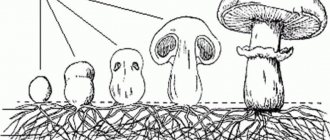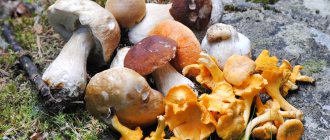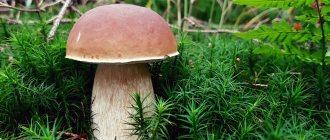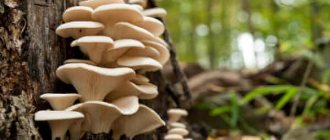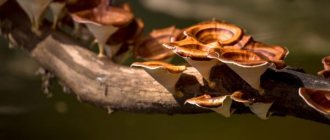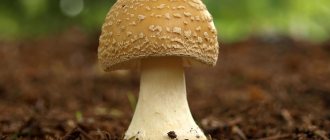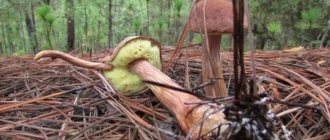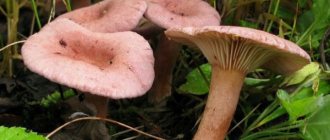Mushrooms
0
1546
Article rating
Kira Stoletova
The cohabitation of two completely different organisms is the basis of all life. Most living organisms cannot live without mutualism. The symbiosis of a mushroom and a tree is also a common phenomenon. As a result, both partners benefit.
Symbiosis of mushrooms and trees
Introductory information
Initially about the symbiosis of mushrooms and trees. This is not a new matter. The symbiosis of plants and fungi is hundreds of millions of years old. To be more precise, about 400,000,000! What is the essence of this phenomenon? Mycorrhizal endofunges have the property of penetrating into the roots of plants and forming mycelium. All this helps strengthen the immune system, absorb water and nutrients from the soil, and fight various pathogens of various diseases. Thanks to mushrooms, plants can take full advantage of the available opportunities. Without the presence of such a symbiosis, it would be necessary to spend additional reserves on the growth of the root system instead of increasing the above-ground part. In addition, mycorrhiza improves soil quality, aeration and porosity. A true symbiosis.
Connection with plants
The symbiosis of fungi with plants, for example, in lichens, leads to constant development, and new functions appear in organisms.
In the middle of the 19th century, it was established that these groups of bodies are a union of algae and fungi, and not individual organisms, as was commonly thought before. In this union, both symbionts receive the greatest benefit. Using chlorophyll, algae form an organic substance - sugar, which the mycelium feeds on, which equally protects against drying out and provides biologically significant elements. It receives these and other minerals from the substrate.
Thus, thanks to symbiotic relationships, the lichen can live both in hot deserts and in high mountains or northern regions. They are found on a variety of surfaces. These mysterious creations of nature consist of 300 compounds and include at least 80 unique elements. The symbiosis of the fungus and plant root increases the life expectancy of the lichen. It is believed that there are species that are more than 10 thousand years old. Common lichens, found everywhere, live about 60-100 years.
What's the benefit?
You may be interested in: Franz Halder, German general: biography, arrest and Dachau concentration camp
Let's talk about this from a scientific point of view. Mycorrhiza is a symbiosis, that is, a mutually beneficial union between the roots of highly organized plants and fungi. In this case, different organisms form a single morphological whole. This is how the fungus feeds the plant and vice versa.
There are two main types of mycorrhiza: endo and ecto. What is important to us? Ectomycorrhiza is the formation of basidiomycete and ascomycete fungi, usually in temperate forests. This is very important for their growth. Sometimes the symbiosis of mushrooms and trees is a matter of successful survival for both representatives. Although both types are not always found. For example, pinacoidal trees never form fungal structures in the roots and intercortical layers. That is, they do not enter into the process of endomycorrhiza.
Desirable and mandatory
Relationships in which plant organisms receive mutual benefit can be classified as mutualistic (mutualism - from the Latin mutuus - “mutual”). Usually, facultative and obligate (from the Latin obligatus - “indispensable”, “obligatory”) mutualism are distinguished.
- In the first case, mutual cooperation helps survival, but is not mandatory for organisms.
- In the second, cooperation is vital for both participating partners.
If the coexisting partners are inseparable and dependent on each other, then such connections are called symbiotic (symbiosis - from the Greek symbiosis - “living together”).
Why is symbiosis so important?
Man actively interferes with natural processes. Chemical fertilizers are applied, heavy equipment is used, construction work is carried out, pipelines, concrete, asphalt are laid, water and air are polluted, dams are built, soil is cultivated, and the like. That is, plants are exposed to unprecedented stress. This weakens the immune system and leads to death. It should be noted that symbiotic organisms have a number of interesting properties. So, for example, mushrooms can be obtained from the root of a tree with which they have entered into a relationship.
Lichens
The next time you go to the forest, take a closer look at the lichens. These unusual types of formations look very solid, but are not a single organism. Lichen is a symbiotic association - a strong lifelong “friendship” of fungi and algae. Fungi provide algae with an environment in which they can survive. Algae release the products of their photosynthesis. It is noteworthy that lichens form only with poor nutrition, moisture and lighting. Improved living conditions will lead to the death of the lichen - the bonds of the symbionts are destroyed, the algae begin to live independently, and the fungi may not survive. But as long as they are together, everything is fine with them. And don’t say that you haven’t happened to admire their almost alien beauty at least once in your life.
How are they built?
The external mycelium is responsible for receiving and transporting nutrients to the plant from the soil. Internal structures are responsible for their transfer from the fungus to the plant. In addition, photosynthesis products are supplied in the opposite direction. It is worth mentioning vesicles here. These are special structures that serve fungi as storage organs. Thus, lipids can be used when photosynthesis deficiency occurs. In this case, fungal spores form in the external mycelium, although they can also form in the roots. They are characterized by a long stay in the soil and serve as a mushroom sprout. When the time comes (temperature, certain soil moisture is appropriate), they try to enter into symbiosis with the roots. This process takes up to one week.
Why are mycelial meshes needed?
Mycelium nets, or simply mycelium, as it is commonly called, for most people is simply called mycelium, consisting of the finest intertwined threads. These filamentous mycelia form special organs that help them gain a foothold in a habitable environment. Such a medium can be the soil surface, the tree itself or its roots. Mycelium performs many very important tasks:
- processing cellulose with enzymes to produce natural fertilizers;
- adaptation to external conditions;
- synthesis of spores and their preservation.
The mycelium in appearance resembles white fluff or a network, as it is represented by the finest threads. These threads have many branches called hyphae. Their thickness is 1.5-10 microns. To understand this size, you need to say that 1 micron is equal to 0.001 mm. The mycelium set consists of bundles that resemble the roots of ordinary plants. They make it possible to adhere to a variety of surfaces, from soft soil to hard wood. In mycorrhiza, other threads enriched with nutritional elements are formed. They are black, their purpose is defense. They allow the mycelium to survive and withstand low temperatures. There is a certain cycle of development and mycelium:
- it all starts with small spores that form the primary type of mycelium;
- crossing cells from a pair of spores contributes to the appearance of a secondary one;
- then comes the secondary growth phase;
- after the vegetative mycelial networks have matured, the cell begins to divide very actively, and when this process reaches its maximum activity, the production of the fruiting body begins;
- after the last change it becomes tertiary.
There is another classification:
- completely submerged is under the nutrient substrate. That is, it is hidden underneath;
- air is connected only with the environment.
And one more classification:
- coenotic or noncellular. There are no side partitions between the cells. It is a single cell with a large number of nuclei inside;
- septate or cellular. Cells are divided into transverse compartments, as a result of which each cell can contain a certain number of nuclei.
Myceliums live on stumps, old rhizomes, tree bark or inside the trunk. This helps to understand which mushrooms are associated with trees, which we will talk about next.
How important are they in the formation of a single mass of soil?
Fertile lands are characterized by a consistently high level of moisture in the soil. These are favorable conditions for a symbiosis of the fungus and tree roots to be created. Their interaction also binds and strengthens its components due to the intensive development of the mycelium, extracellular polymer components, as well as glycoproteins. Let's consider an example with sandstone. Mycorrhizal plants can grow in it. So, the sand in their root system is about five times more connected than that of similar biomass that has not acquired a symbiotic relationship.
What trees do mushrooms grow under?
There are species for which symbiosis is important only with certain crops, for example, black truffle and chestnut. Most mushrooms can choose different tree species and differ mainly in their classification (coniferous or deciduous).
Birch
A lot of mushrooms like to create mycorrhizae with birch, and the first thing is boletus. In addition to them, the following grow under it:
- obabok;
- food and green russula;
- purple row;
- white truffle;
- milk mushroom;
- waves;
- valui;
- thin pigs.
Oak
The mighty perennial giant is loved by the porcini mushroom's counterparts - speckled oak mushrooms, as well as:
- peppery, blue and dry milk mushrooms;
- pigs;
- pink russula;
- oak mushrooms;
- milk jugs.
Aspen
This tree is loved by:
- boletus;
- aspen and dog milk mushrooms;
- Russula;
- value.
Conifers
They prefer spruce and pine:
- boletus;
- saffron milk caps;
- pigs;
- boletus;
- flywheels;
- red and yellow milk mushrooms.
Absorption of nutrients
The symbiosis between mushrooms and trees allows for accelerated development of the plant. So, if their above-ground part does not increase much, then changes definitely occur in the root system. Mycorrhizal plants generally receive a more balanced diet to help them grow and maintain a healthy state. In addition, resistance to a/biotic factors also increases.
What does the absorption process look like from a chemical point of view? This mainly depends on the absorptive capacity of the root, the availability and distribution of nutrients, and the appropriate micronutrient content in the soil. Let's take a closer look. The ability to absorb highly mobile ions, such as NO3-, depends on the plant species. Whereas representatives of chemical elements with a low diffusion rate, such as Zn, P, NH4+ and others, are absorbed in direct proportion to the density of the root per volume of soil. And in such cases, the morphology of the root and the external mycelium turn out to be decisive. This is the alpha and omega on which the symbiosis of mushrooms and trees rests.
You - for me, I - for you
In the world of wildlife, symbiosis is a kind of interaction between two organisms of different species, benefiting both of them. There are a huge number of examples of such symbiosis - from the famous friendship of hermit crabs with the coral polyp sea anemone, which settles on their shell and protects the crayfish from enemy attacks with its stinging threads in exchange for the ability to move along the bottom and find food faster, to bacteria that live in the digestive tract human system and ensuring us successful digestion and assimilation of food.
Mushrooms are also big fans of entering into symbiotic relationships with a wide variety of living organisms, and this article talks about the peculiarities of the life of symbiont fungi.
Connection with plants
The symbiosis of fungi with plants, for example, in lichens, leads to constant development, and new functions appear in organisms. In the middle of the 19th century, it was established that these groups of bodies are a union of algae and fungi, and not individual organisms, as was commonly thought before. In this union, both symbionts receive the greatest benefits.
Using chlorophyll, algae form an organic substance - sugar, which the mycelium feeds on, which equally protects against drying out and provides biologically significant elements. It receives these and other minerals from the substrate.
Thus, thanks to symbiotic relationships, the lichen can live both in hot deserts and in high mountains or northern regions. They are found on a variety of surfaces. These mysterious creations of nature consist of 300 compounds and include at least 80 unique elements. The symbiosis of the fungus and plant root increases the life expectancy of the lichen. It is believed that there are species that are more than 10 thousand years old. Common lichens, found everywhere, live about 60-100 years.
Cooperation between different species is the basis of all life on our planet. The symbiosis of fungi and plants arose in response to their need for survival. Most higher crops can no longer exist without mycorrhiza, since the soils have been depleted and the number of negative factors has increased.
Manifestation of symbiosis of fungi with plants and trees
Human interaction
Man constantly lives in collaboration with a large bacterial community, represented by several dozen major families. There are no microbes only in the blood and lymph. All other organs and tissues, one way or another, come into contact either with the bacteria themselves or with the products of their vital activity.
Gastrointestinal tract
The gastrointestinal tract is inhabited by symbionts of the Enterobacteriaceae family. This is the largest community, which includes genera of intestinal pathogenic and opportunistic microorganisms. Also in the gastrointestinal tract there are a large number of representatives of the Lactobacillus family - these microorganisms create an acidic environment that suppresses the activity of bacterial and viral pathogens; Lactobacilli also cleanse the intestines of rot.
Skin
Human skin is inhabited by microorganisms no less than the gastrointestinal tract. Staphylococcus epidermidis, coryneform bacteria, Proteus, propionibacteria, pseudomonads, intestinal microbes and others are present on the skin.
Bacteria on human skin
The activity of microbes that inhabit the skin depends on the presence of many inhibitory factors, as well as factors that stimulate the development of a favorable environment for the growth of a particular type of bacteria. As soon as such an environment is created, a certain bacterial form immediately begins to predominate in this bacterial community, which is most often accompanied by infection of the skin. Under normal conditions, when one group restrains another, such interaction is a natural biological shield.
Oral cavity
The presence of bacterial symbiosis has also been established in the mouth, which regulates the internal environment of the oral cavity and does not allow pathogenic microflora to become active, thereby protecting the tissues of the oral cavity itself and the upper respiratory tract from infectious infections.
